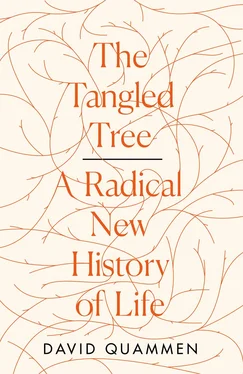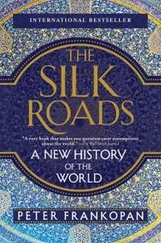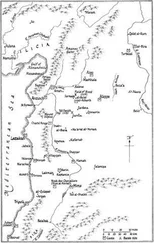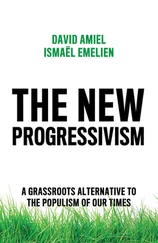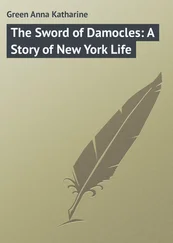Across the room, some films lay on the tables, where Franch had been working over them. He showed me three large sheets, carefully taped together, forming a triptych of images. I stared at the patterns of dark spots: amoebae galloping on a plain. To me, they made no particular sense. But to Woese, they had spoken eloquently of identity, relationship, evolution. If something was odd, he would have seen it.
This is delta H, Franch said.
Immediately after his epiphany, Woese shared it with George Fox, the postdoc he had assigned to work with Bill Balch on growing the methanogens. As recalled later by Fox, Woese “ burst into my room in the adjoining lab” with the announcement that they had something unique. From there he proceeded throughout the lab, among his young students and assistants, “ proclaiming that we had found a new form of life. He then pointed out,” by Fox’s memory, tart and amused, “that this was of course contingent on my having not screwed up the 16S rRNA isolation.” Being cautious, they repeated the whole process with delta H and got the same result. So no, Fox hadn’t screwed up.
“George was always skeptical,” Woese himself wrotelater about their reactions to the discovery, adding that he valued such skepticism as good scientific instinct. Fox’s doctorate in chemical engineering suited him well to offset epiphanic leaps, even by the boss, with empirical caution. In fact, their shared instinct for skepticism about such a startling result helps explain why these two men worked so well together. But the anomalies in the fingerprints persuaded Fox too. By his account, they seemed to “jump off the page,” and he agreed that those differences suggested a third, very distinct form of life.
Still, Woese and Fox both knew that convincing other scientists of such an epochal discovery would be difficult. More data were needed. So the Woese lab went back to work, with Balch’s methodology and help, on culturing and fingerprinting still another methanogen. Woese and his colleagues worked quietly, for the time being. By the end of 1976, they had five additional genetic catalogs from five more methanogenic microbes, all quite different from one another but sharing signs of a much greater, much deeper, and shared difference from anything else known to exist.
Bacteria are versatile and diverse. That’s an understatement. Widespread—another understatement. They are hard to categorize, hard to identify, hard to sort into related groups, as even Stanier and van Niel finally admitted. They are nearly ubiquitous across most parts of Earth’s expanse, in both natural and human-made environments, floating through the air, coating surfaces everywhere, awash in the oceans, even present in rocks deep underground. Your skin as I’ve said is covered with them. Your gut is teeming. Your human cells may be outnumbered by them at a three-to-one ratio in your body. Bacteria live also in mudholes and hot springs and puddles and deserts, atop mountains, deep in mines and caves, on the tabletops at your favorite restaurant, and in the mouths of you and your dog.
A species called Bacillus infernus has been cultured from core samples of Triassic siltstone, buried strata at least 140 million years old, drilled up from almost two miles beneath eastern Virginia. Under the Pacific Ocean, 35,755 feet deep in the Mariana Trench, lie sediments that have also yielded living bacteria. In Antarctica, a body of water known as Subglacial Lake Whillans, lidded by half a mile’s thickness of ice and supercooled to just below zero, harbors a robust community of bacteria. They thrive there in the darkness and cold, eating sulphur and iron compounds from crushed rock.
Then again, some like it hot. Those are called thermophiles. Among the most famous of thermophilic bacteria is Thermus aquaticus , first cultured from a sample collected in Yellowstone National Park by the microbiologist Thomas Brock and a student, Hudson Freeze, in 1966. Brock and Freeze had found it in a steaming, multicolored pool called Mushroom Spring, in Yellowstone’s Norris Geyser Basin, at a temperature of about 156 degrees Fahrenheit. Functioning in such heat, Thermus aquaticus contains a specialized enzyme for copying its DNA, one that performs well at high temperatures, which became a key element in the polymerase chain reaction technique for amplifying DNA. That technique, widely useful in many aspects of genetic research and biotech engineering, earned its chief developer (but not Thomas Brock) a Nobel Prize.
Other heat-loving bacteria can be found around hydrothermal vents on the sea bottom, where they help anchor the food chains, producing their own organic material from dissolved sulfur compounds vented out with the hot water, and being fed upon by little crustaceans and other animals. A giant tube worm, one of those gaudy red creatures that waggle around such vents, with no mouth, no digestive tract, gets its nutrition from bacteria growing within its tissues.
By one estimate, the total mass of bacteria exceeds the total mass of all plants and animals on Earth. They have been around, in one form or another, for at least three and a half billion years, strongly affecting the biochemical conditions in which most other living creatures have evolved. That we don’t see bacteria is simply because our eyes are not calibrated to the appropriate scale. There may be more than a billion bacterial cells in an average ounce of soil, and five million in a teaspoon of fresh water, but we can’t hear their crackle or their fizz. A single kind of marine bacteria known as Prochlorococcus marinus , which drifts free in the world’s tropical oceans and photosynthesizes like a plant, may be the most abundant creature on Earth. One source places its standing population at three octillion individuals, a number that looks like this: 3,000,000,000,000,000,000,000,000,000.
They vary in shape and in size—interestingly in shape, drastically in size. A bacterial cell, on average, is about one-tenth as big as an animal cell. At the upper end of the range is Thiomargarita namibiensis , an odd thing discovered on the sea floor near Namibia, its cells ballooning up to three-quarters of a millimeter in diameter, stuffed with pearly globules of sulfur. At the lower end of the range is Mycoplasma hominis , a tiny bacterium with a tiny genome and no cell wall, which manages nonetheless to invade human cells and cause urogenital infections.
Bacterial shapes, as I’ve mentioned, range through rods, spheres, filaments, and spirals, with variations that in some cases represent adaptations for movement or penetration. It turns out that their geometries, notwithstanding the efforts and convictions of Ferdinand Cohn, are unreliable guides to their phylogeny. Shape can be adaptive, but adaptations can be convergent as well as ancestral. Roundness may be good as a hedge against desiccation. Elongation as a rod or filament seems to help with swimming, and a flagella definitely does. Filamentous bacteria that are star shaped in cross section, recently discovered in a wonderfully named substance called “mine-slime,”deep in a South African platinum mine, may profit from all their surface area by way of enhanced absorption in nutrient-poor environments. The twisting motion of spirochetes, such as the ones that cause syphilis and Lyme disease, evidently allows them to wiggle through obstacles that other bacteria can’t easily cross, such as human organ linings, mucous membranes, and the barrier between our circulatory system and our central nervous system—a fateful degree of access. Even the less dynamic shapes, the short rods known as bacilli, the spheres known as cocci, and the rods slightly curved like commas, serve well enough the bacteria responsible for a long list of diseases: anthrax, pneumonia, cholera, dysentery, hemoglobinuria, blepharitis, strep throat, scarlet fever, and acne, among others.
Читать дальше
